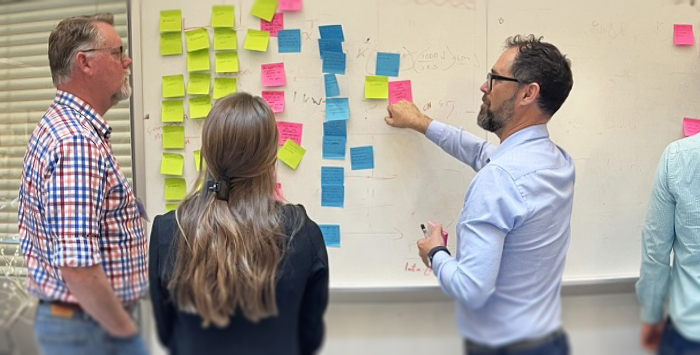
A water “control center”: Developing the Arizona Water Observatory with stakeholder engagement
Water is a vital resource, and Arizona faces ongoing challenges in managing and conserving water effectively. Currently, decisions related to water supply, ranging from agricultural allocations to construction permits, are slowed down by delays in obtaining accurate, up-to-date water data. In addition, high costs, limited adaptability to future challenges and data accessibility barriers often hinder effective decision-making.
The Arizona Water Observatory (AWO) – envisioned as water control center running on an open-source, map-based platform – aims to provide solutions to these challenges by bridging existing gaps in water data accessibility, streamlining decision-making and enhancing collaboration among water agencies, municipalities, agricultural stakeholders, researchers and other groups.
To ensure that the AWO is useful to a broad array of stakeholders, on February 24, 2025, the Arizona Water Innovation Initiative (AWII) and Center for Hydrologic Innovations (CHI) at ASU hosted a workshop alongside the Internet of Water team at the Center for Geospatial Solutions, the implementation partner helping local, state, and federal agencies modernize open water data systems.
The event gathered 28 water experts, data stewards and decision-makers from 11 organizations across Arizona, all working to shape a platform that will revolutionize the way the state manages its water resources. Their combined efforts ensured that diverse voices, ranging from state agencies and water management experts to local municipalities and research institutions, were included, providing a holistic view of Arizona’s water data needs and challenges.
Workshop structure
The workshop was designed to foster collaboration and gain comprehensive insights from a variety of stakeholders. Participants engaged in animated individual, small-group and large-group discussions, each intended to generate in-depth feedback.
“The workshop was focused on three primary goals,” says Enrique Vivoni, ASU professor, director of CHI and pillar lead with AWII. “The first was to identify key data needs. Participants shared what kinds of water data would be most useful to them, focusing on how data could be accessed, visualized and used to support real-time decision-making.”

Second, the group focused on developing detailed use cases. Working together, attendees worked through the most pressing water management challenges and outlined how the AWO could address these challenges through specific use cases such as agricultural water use, groundwater recharge and flood risk analysis.
Finally, participants were asked to prioritize features and functionalities. The workshop helped pinpoint which features would deliver the most value to users, prioritizing them for development in the first version of the platform.
Outcomes and insights
The workshop provided several key outcomes that will guide the next steps in AWO’s development. For example, participants generated 15 use cases, which illustrated how the AWO could be used across a wide range of scenarios.
From conservation analysis and watershed management to property assessments and groundwater recharge mapping, these use cases highlighted the diverse ways in which the platform could support Arizona’s water managers, municipalities, farmers and researchers.
“These use cases emphasized the need for the platform to provide high-priority data types,” says Vivoni. “Users want real-time water usage and quality monitoring, advanced analytical tools to forecast future water availability and help make informed decisions on water allocations.”
Participants also stressed the need for user-friendly interfaces that enable stakeholders to visualize complex water data in an accessible, actionable format.

In addition, the AWO platform will serve as a critical tool for decision making for water agencies, providing a comprehensive, real-time view of Arizona’s water resources. This will allow organizations including SRP, CAP and ADEQ to make more data-driven decisions, ensuring water is allocated and used efficiently across sectors.
“Users will be able to better forecast future water needs, ensuring the state can plan for long-term sustainability in light of population growth and climate change,” says Vivoni, “as well as improve collaboration between government agencies, researchers and private sector stakeholders to tackle complex water management challenges.”
For example, municipalities will be able to monitor water quality and distribution more effectively, while agricultural stakeholders can better track water usage and optimize irrigation practices. Researchers will have easier access to data, supporting studies on water conservation and climate adaptation.

Beyond agencies and researchers, the AWO platform has the potential to empower Arizona residents in meaningful ways. The platform will make water data more accessible and understandable for everyday users, from homeowners to business owners.
For example, it will provide residents with easy access to local water availability, helping them make informed decisions on water conservation efforts, support community engagement by allowing residents to track how their water usage compares to regional goals for conservation and sustainability, as well as help farmers and ranchers access timely data on groundwater levels and weather patterns, enabling them to adjust their practices and conserve resources.
“In essence, the AWO will make water data more transparent and actionable,” says Vivoni. “This will foster a more informed and proactive approach to water stewardship across the state.”
It is also important to note that the workshop revealed significant gaps in current water data systems. Stakeholders stressed the importance of standardizing metadata, ensuring that data is accurate and consistent across platforms. Additionally, participants pointed to the need for the AWO to provide mechanisms for data stewardship, ensuring that information is maintained, updated and shared properly to support long-term water management goals.
Another major takeaway was the need for the AWO to be interoperable with existing systems used by Arizona’s water agencies and organizations. The platform will be designed to integrate seamlessly with tools already in use, such as weather forecasting systems, irrigation management systems and hydrological models, ensuring that stakeholders can continue to leverage existing investments in technology.
Looking ahead
With valuable feedback in hand, the next phase of the project, the design stage, will begin. During this phase, the focus will be on developing the user interface to ensure it is intuitive, user-friendly and capable of supporting a wide range of stakeholders, from technical experts to non-technical users.
In addition, a technical workgroup, comprising key experts and agency representatives, will meet regularly throughout 2025 to provide ongoing feedback and guidance as the platform is built.
“The AWO platform is poised to transform Arizona’s water management landscape by providing better access to critical water data, improving forecasting and decision-making capabilities and empowering stakeholders across the state,” says Vivoni. “This workshop was an essential step toward defining the system’s features, gathering feedback from users and aligning its development with the needs of Arizona’s diverse water management community.”
As AWO development progresses, the insights from this workshop help to ensure that the platform's development directly aligns with the needs of the people who rely on water data to make decisions. By building a tool that makes water data more accessible, actionable and reliable, the Arizona Water Observatory will help the state navigate its water challenges and build a more sustainable future for all.
“The AWO is a digital transformation effort,” says Vivoni. “It is about the future of managing water information.”
For further information, read the full workshop report.
Related stories: